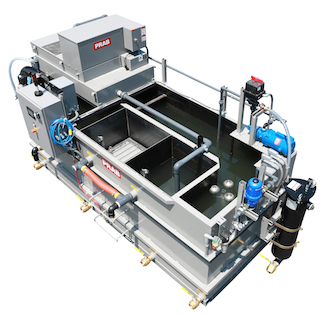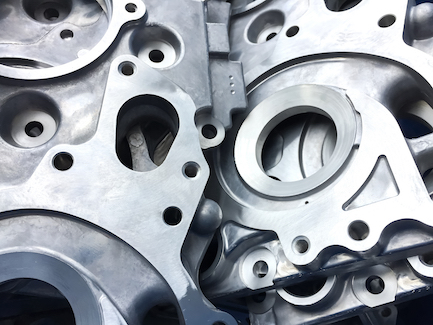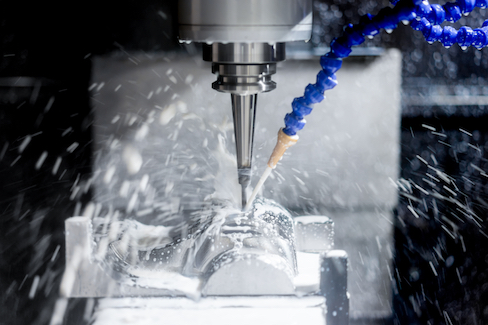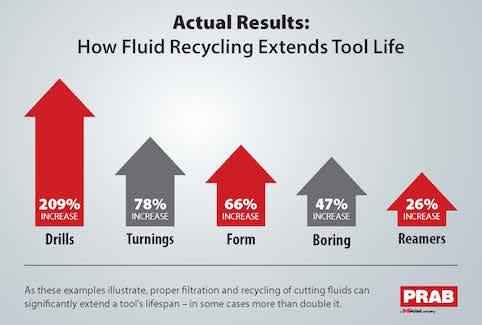Extend Your Cutting Tool Investment By Up to 25%
Cutting tools account for 3% to 5% of manufacturing costs, so anything that extends their life will improve profitability. By minimizing waste and freeing employees to perform higher-value work, automated fluid recycling systems pay for themselves in less than a year.
Posted: November 18, 2020
SMOOTH OPERATIONS COLUMN
BY MIKE HOOK
It’s especially important during challenging market conditions for machining companies to minimize unnecessary expenses. One way to do that is to install an automated fluid recycling system that recovers and returns used cutting fluid back the machine.
Systems can be machine-side or centralized to accommodate multiple CNC machines depending on flow rate and cutting operation. Designed for continuous operation, the equipment removes tramp oils and suspended solids from contaminated fluid and thwarts the growth of bacteria by monitoring and automatically adjusting water and coolant concentration levels.
Fluid recycling systems are easy to operate and require minimal training. In addition to lowering your annual fluids investment by up to 75%, they improve part quality by lowering surface roughness and maximize uptime by extending tool life up to 25% and fluid life two to five times.
They also reduce fluid disposal costs by up to 90%, generating substantial savings in hazardous waste disposal costs. One customer, for example, used to consume four drums (220 gallons/832 liters) of new fluid and dispose of 1,189 gallons/4,500 liters every seven to eight days. Since installing our Guardian recycling system, the machining company now consumes four gallons every 28 days and disposes of it every 83 days. That’s a reduction of approximately 75% and 92%, respectively.
Because of savings like these, the right system usually pays for itself in six to nine months.
Two Options for More Effective Filtration
Even before the 2020 economic downturn, multiple studies showed the skills gap could cause an estimated 2.5 million manufacturing jobs to go unfilled. The pandemic requires manufacturers to rethink factory floor layouts so fewer employees are concentrated in a particular area. Automating fluid recycling therefore makes practical as well as financial sense.
One relatively new option on most fluid-recycling systems reduces the need for operator intervention even further: automatic coolant concentration control via an embedded refractometer. The sensor continuously tests for Brix to maintain a chemical-to-water concentration ratio of +/-1%. When the ratio drops below that, the system automatically adds more chemical and less water to bring it back up. When the ratio rises above that, the system adds more water and less chemical to bring the concentration level down.
This capability enhances the work environment by reducing sump maintenance, thereby lowering employees’ exposure to lubricants that could cause health problems and lead to medical claims.
Another option helps prevent rancidity, a major cause of fluid failure, without using biocide. Coolant manager modules minimize bacteria growth by continuously injecting ozone into the cutting fluid. Ozone is a safe, economical way to eliminate odors and prevent skin irritations by killing bacteria, yeast, fungus, and mold.
Extend Tool Life and Improve Part Quality
Protecting capital investments directly impacts the financial health of a metalworking operation. Cutting tools can account for 3% to 5% of total manufacturing costs, so these assets should be properly cared for.
That is one of the greatest advantages an automated recycling system brings. Cutting fluid management is a key technique for extending tool life. In fact, one worldwide manufacturer of complex components saw drastic increases in tool life:
- Drills: 209%
- Turning: 78%
- Form: 66%
- Boring: 47%
- Reamers: 26%
Making the Most of Your Labor Costs
Finally, by investing in back-end equipment, metalworking operations can efficiently reallocate labor – often the largest operational expense – more effectively. A proactive approach to operational improvements like automated cutting fluid recycling can be especially helpful for shop managers trying to reduce financial strains during difficult market conditions.



















